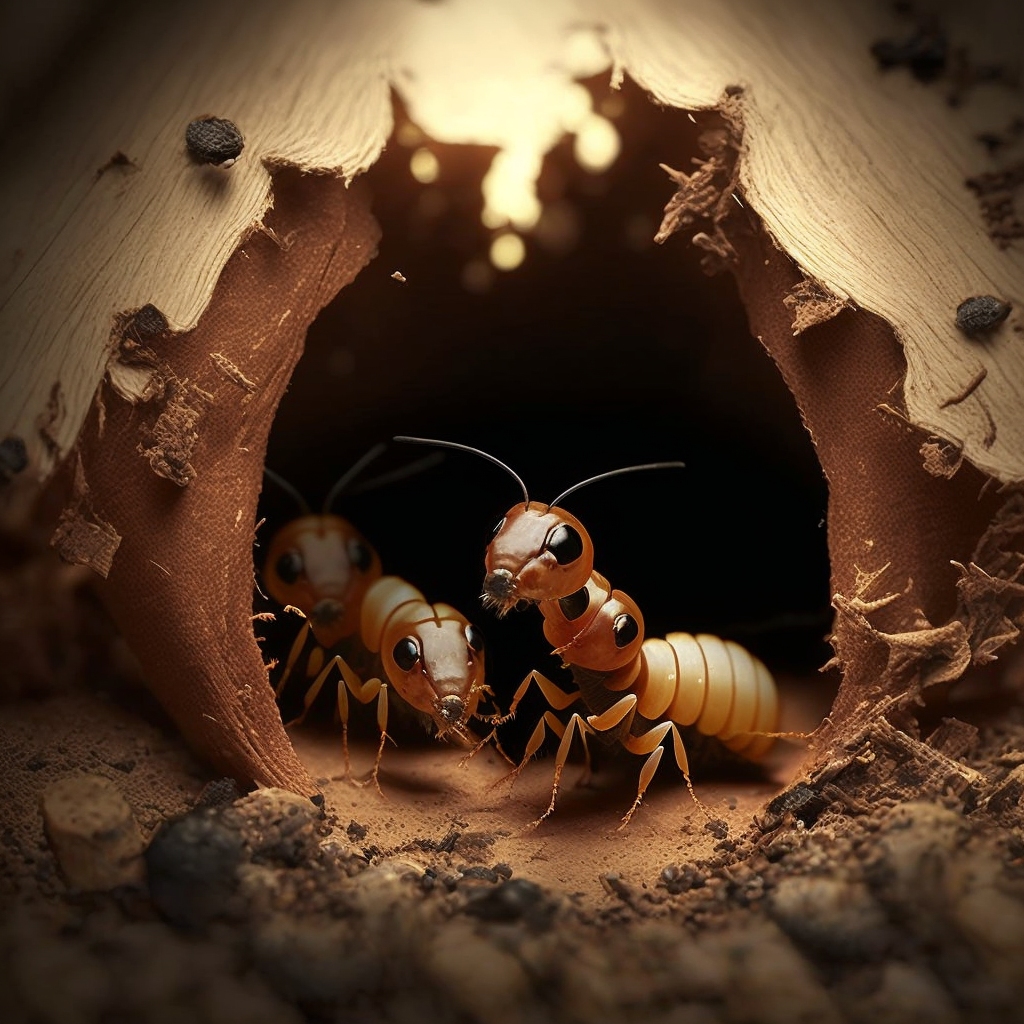What Are Termite Mud Tubes and what do they look like

What Are Termite Mud Tubes
Termite mud tubes are made of soil and saliva, and are between 1/4- to 3/4-inches in diameter. These structures look like small dirt or mud pipelines protruding from the ground or on walls inside homes.
The open ends of these mud tubes usually have a funnel shape that allows workers easy access into the structure.
This is because termites need moisture to survive, so they build them near sources of water such as plumbing leaks, condensation pipes, or baseboards with high humidity. Termite mud tubes also help protect them from predators and environmental changes.
They can be found both outdoors and indoors, but are most common in areas where there is excess moisture.
When you spot these signs around your home, it is important to contact a termite control professional.
While they may look harmless, they can cause serious damage if left unchecked.
What Do Termite Mud Tubes Look Like
Termite mud tubes are typically made of soil and saliva, so they are usually dark in color and feel gritty to the touch.
They may also be accompanied by small particles of wood or other debris that termites have chewed through. They range from pencil thick to about an inch, depending on the species of termite and size of their colony.
If you suspect you may have termites in your home, it is important to inspect for signs of these mud tubes as soon as possible and take action before the problem worsens.
Inspection for potential infestation should include thorough visual inspection around windows, doors, pipes, and any other opening in the foundation.
It is also important to inspect areas where wood meets the soil such as decks and porches. These mud tubes are often found on exterior walls or near plumbing fixtures and water lines.
The tubes may be more visible during the summer months when temperatures rise and termites become more active in their search for moisture. If you find mud tubes, it may be a sign of an infestation.
In this case, it is important to contact a pest control service to determine the extent of the problem and develop a plan of action for treatment.
Termite mud tubes can cause costly damage if left unchecked, so it is important to identify them early and take necessary measures for prevention and control.
How Do Termites Build Mud Tubes

The mud tubes constructed by termites are made from a combination of soil, saliva, and feces. This mixture creates a waterproof tunnel which protects the termites from extreme temperatures and predators.
The mud tubes are essential for the survival of the colony as they not only provide protection, but also a way to transport food back to their nests.
Once built, the mud tubes are usually around 1-4 centimeters in diameter and can reach up to 12 inch long.
Mud tubes can provide many benefits for the termite colonies. They act as a defense mechanism against predators such as ants, lizards and birds that might be looking for a meal.
The tubes also help keep the colony safe from extreme temperatures by controlling the amount of heat and cold entering or exiting the structure.
Finally, they can offer protection from moisture which is important since these insects are adapted to dry climates.
The walls of the tube are incredibly strong and nearly impossible to break through. In order to create such a long tunnel, termites work together in an organized fashion with each one having its own role.
Some gather soil while others mix it with saliva and feces before proceeding to build upwards and create an arched structure known as a header or dome at the top which allows air flow throughout the length of the tunnel.
In addition, some members of the colony will travel in and out of the mud tube, bringing food back to share with the rest of their community.
By working together, termites are able to accomplish tasks that would be impossible for a single individual to do on its own.
Termite mud tubes are essential to many species as they are used not only for transporting food but also as shelter and protection from predators.
In addition, they can help regulate temperature and moisture levels which is critical in hot and dry climates.
Not only this, but mud tubes can be used to expand territory and find new resources. Therefore, it is no surprise that termites have been using these tunnels since ancient times and continue to build them today!

Why Do Termites Build Mud Tubes
Mud tubes are built by termites in order to keep their colonies safe and secure from predators. The mud tubes provide a protected area for the termites to travel between their food source and their colony without being exposed to the open air.
The mud tubes are also used as a form of insulation, trapping in warmth and moisture from the environment which is essential for the health of the colony.
Termite colonies rely on these mud tubes for their survival, so it is vital that they are kept intact at all times.

To do this, termites work together to build and maintain them by gathering soil and other material such as wood fibers or dead plants and mixing them with saliva to form a paste-like consistency.
This material is then used to build walls around the colony that protect it from harsh weather conditions and predators while providing an area where they can move safely around with little risk of discovery.
The mud tubes also provide an environment where termites can forage for food and search for new colonies to expand into.
The presence of mud tubes around a dwelling is one of the first signs of a termite infestation, so if you suspect that you may have an issue with these pests, it’s important to contact a professional exterminator right away.
With their help, you can rid your home or business of these destructive creatures and get back to living in peace.
Damage that can Be Caused By Termite Mud Tubes
Termite mud tubes are a common sign of subterranean termite infestations, since they allow the pests to travel back and forth from the soil to their nesting sites. Left unchecked, these mud tubes can cause a lot of damage to your home.
The main form of destruction caused by termites is wood damage. Subterranean termites feed on wood and other forms of cellulose-based materials that are found in homes like cardboard and paper products.
They will tunnel through wooden beams, flooring, paneling, furniture, and even books in order to access food sources. This type of damage can be extensive if left untreated for long periods of time.
In addition to structural damage, termite mud tubes can be a sign of an infestation. If you notice mud tubes on your walls or other areas of your home, it is important to contact a professional pest control company as soon as possible.

This will help you get the problem under control before any major damage is done.
Finally, termite mud tubes can also lead to other health risks in your home. The pests themselves are not particularly dangerous but they do carry parasites and bacteria that can be harmful if ingested or inhaled by humans.
This means that regular inspections should be conducted by trained professionals to ensure any potential problems are addressed quickly and effectively.
It is clear that termite mud tubes can cause serious damage if left unchecked for too long. From structural destruction to health risks, the consequences of a termite infestation should not be taken lightly.
Regular inspections and prompt treatment are essential to keep your home safe and healthy for you and your family.
The best way to protect your home from costly repairs is by being aware of the warning signs of termite mud tubes and taking action as soon as possible.
If you think you may have an issue with termites in your home, contact a professional exterminator immediately for help. With the right expertise and tools, they can get rid of the problem quickly before any serious damage is done.
Take action now – don’t wait until it’s too late!
How To Get Rid of Termite Mud Tubes
Once you have identified the mud tubes and determined that they are indeed caused by termites, it is time to get rid of them. The first step is to remove any existing mud tubes as soon as possible.
This can be done either manually or with an insecticide specifically designed for killing termites.
Manually removing the mud tubes involves scraping them away with a tool such as a putty knife or razor blade.
Make sure to wear protective gloves and goggles during this process in order to protect yourself from any dust or debris created.
Using an insecticide labeled for use against subterranean termites is another option. It typically comes in either a liquid or powder form and should be applied directly on the mud tube itself, using a sprayer or duster.
Carefully follow the instructions on the product label for best results.
Once you have removed the mud tubes, it is important to inspect and treat any other areas where termites may be present.
This may include looking for and removing any wood that has been damaged by the termite activity and applying a borate-based insecticide to protect against future infestations.

Conclusion
You should also take steps to ensure that your home remains as dry as possible in order to prevent another outbreak of termites from occurring. Make sure gutters are clean and unclogged, repair any leaking plumbing fixtures, and seal up any gaps or cracks around doors or windows in order to reduce moisture retention. Additionally, you may want to consider investing in a dehumidifier to further help reduce the amount of moisture in your home. Taking these preventative steps can go a long way toward discouraging termites from returning.
With the right approach and diligent monitoring, you can successfully get rid of termite mud tubes and protect your home against future infestations. By following the tips outlined above, you can effectively eliminate any existing termite activity and decrease your chances of experiencing another costly problem in the future. With the proper steps taken, it is possible to have a safe and secure home for years to come.



